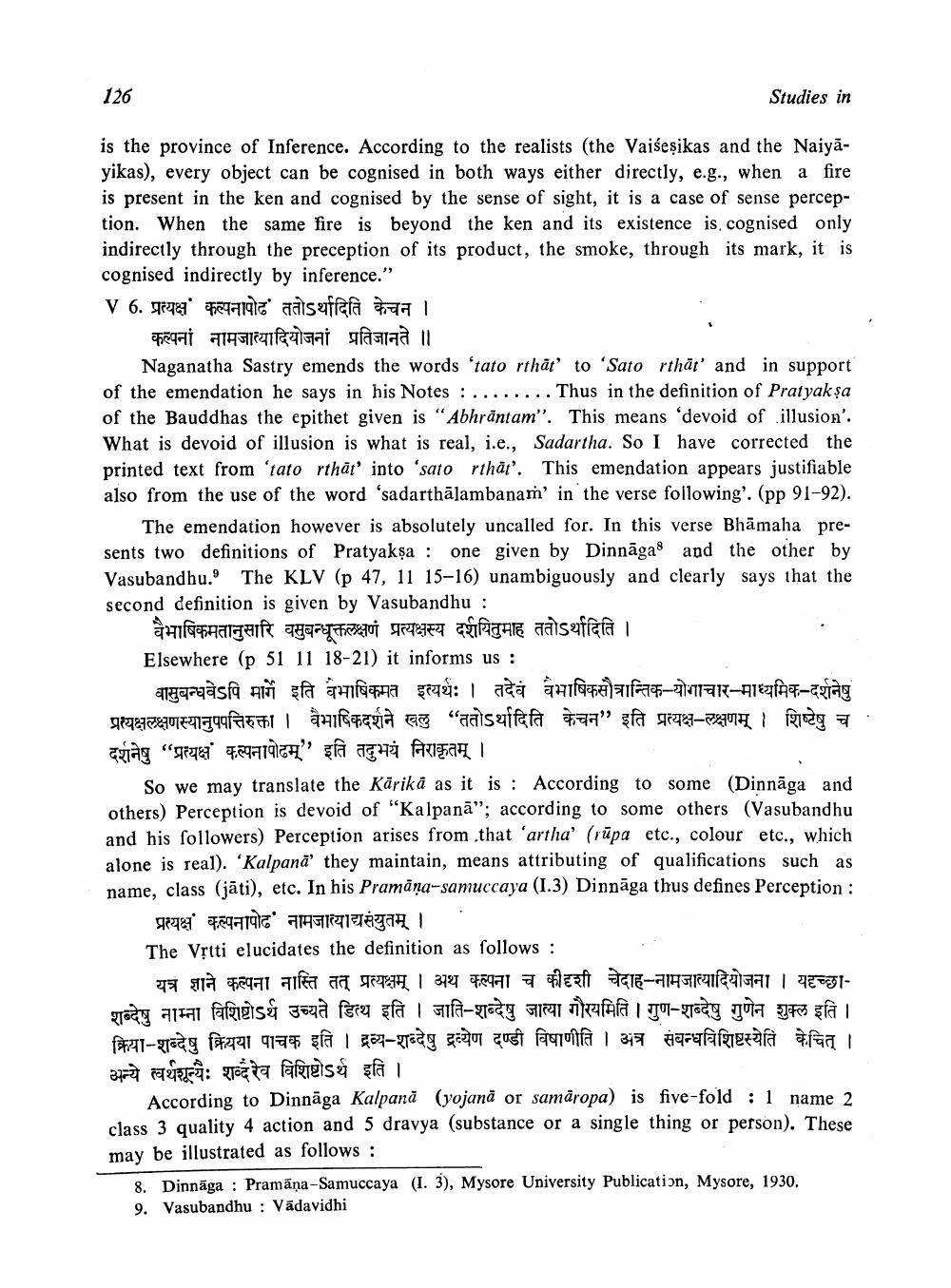________________
126
is the province of Inference. According to the realists (the Vaiśesikas and the Naiyayikas), every object can be cognised in both ways either directly, e.g., when a fire is present in the ken and cognised by the sense of sight, it is a case of sense perception. When the same fire is beyond the ken and its existence is, cognised only indirectly through the preception of its product, the smoke, through its mark, it is cognised indirectly by inference."
6. प्रत्यक्ष कल्पनापोढ ततोऽर्थादिति केचन ।
कल्पनां नामजात्यादियोजनां प्रतिजानते ॥
Studies in
Naganatha Sastry emends the words 'tato rthat' to 'Sato rthlt' and in support of the emendation he says in his Notes: ........ Thus in the definition of Pratyakşa of the Bauddhas the epithet given is " Abhrāntam". This means devoid of illusion'. What is devoid of illusion is what is real, i.e., Sadartha. So I have corrected the printed text from 'tato rthat' into 'sato rthat'. This emendation appears justifiable also from the use of the word 'sadarthalambanam in the verse following'. (pp 91-92).
The emendation however is absolutely uncalled for. In this verse Bhāmaha presents two definitions of Pratyakṣa: one given by Dinnagas and the other by Vasubandhu. The KLV (p 47, 11 15-16) unambiguously and clearly says that the second definition is given by Vasubandhu :
वैभाषिकमतानुसार वसुबन्धूतलक्षणं प्रत्यक्षस्य दर्शयितुमाह ततोऽर्थादिति ।
Elsewhere (p 51 11 18-21) it informs us:
वसुबन्धवेऽपि मार्गे इति वैभाषिकमत इत्यर्थः । तदेवं वैभाषिकसौत्रान्तिक- योगाचार माध्यमिक दर्शनेषु प्रत्यक्षलक्षणस्यानुपपत्तिरुक्ता वैभाषिकदर्शने " ततोऽर्थादिति केचन" इति प्रत्यक्ष-लक्षणम् शिष्टेषु च दर्शनेषु "प्रत्यक्ष कल्पनापोढम् इति तदुभयं निराकृतम् ।
So we may translate the Kärikä as it is: According to some (Dinnaga and others) Perception is devoid of "Kalpana"; according to some others (Vasubandhu and his followers ) Perception arises from that 'artha' (ripa etc., colour etc., which alone is real). Kalpana' they maintain, means attributing of qualifications such as name, class (jäti), etc. In his Pramāṇa-samuccaya (1.3) Dinnaga thus defines Perception:
प्रत्यक्ष कल्पनापोढ नामजात्याद्यसंयुतम् ।
The Vrtti elucidates the definition as follows:
यत्र ज्ञाने कल्पना नास्ति तत् प्रत्यक्षम् । अथ कल्पना च कीदृशी चेदाह - नामजात्यादियोजना । यदृच्छाशब्देषु नाम्ना विशिष्टोऽर्थ उच्यते द्वित्य इति । जाति शब्देषु जात्या गौरयमिति । गुण-शब्देषु गुणेन शुक्ल इति । क्रिया-शब्देषु क्रियया पाचक इति । द्रव्य-शब्देषु द्रव्येण दण्डी विषाणीति । अत्र संबन्धविशिष्टस्येति केचित् । अन्ये स्पर्धशून्यैः शब्दरेव विशिष्टोऽर्थ इति ।
According to Dinnāga Kalpana yojana or samaropa) is five-fold 1 name 2 class 3 quality 4 action and 5 dravya (substance or a single thing or person). These may be illustrated as follows:
8. Dinnāga : Pramāna Samuccaya ( I. 3), Mysore University Publication, Mysore, 1930. 9. Vasubandhu : Vādavidhi




